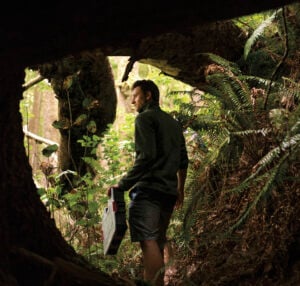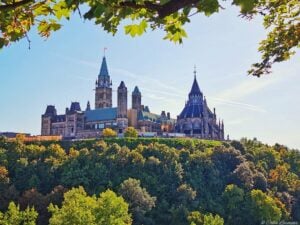
Science & Tech
The hidden world of fungi
As fungi bloom into the mainstream, a research station hidden in the B.C. Rainforest aims to uncover some of the mysteries of mushrooms
- 2277 words
- 10 minutes
Environment
The fun guy behind the mushroom hunt that became North America’s largest fungi bioblitz

Last year, as the leaves turned amber and loosened from the branches that held them, something was happening on the forest floor. In the moist shadow of the canopy’s cover, an omnipresent being, which waxes and wanes with the seasons, blooms fruiting bodies from rotting logs, from the earth of the forest floor, from the bark of living trees. Mushrooms. Lichens. (Algae living amongst the filaments of a fungus.) Slime moulds. And in hot pursuit — in this particular month — humans.
Among them, 36-year-old Robert Courteau organized this month-long adventure in an effort to find and record as many fungi, lichens and slime moulds as possible to create a snapshot in time of the fungi world around us. The so-called FungiQuest far surpassed anyone’s expectations, tapping out more than 150,000 observations.
Ottawa-based Courteau, who partnered with Australian tech company BioSMART for their technological expertise, spoke with Canadian Geographic on how FungiQuest came to be — and how fungi may just be our greatest allies for the problems our world is facing.


On how he got into mushrooms
I’m a former chef. As I entered my culinary career, during the whole farm-to-table movement, I started gardening fruits and vegetables. Then I moved to Prague, Czech Republic. And while I was there, I was introduced to their national pastime, which, like a lot of central Eastern Europe, was mushroom hunting. At the beginning, it was basically what is edible, right from a chef’s point of view. From there, it was: well, what’s poisonous, so that I know I’m not picking those. I started to learn the other mushrooms that were in the woods, and then it just kind of spiralled out of control, really. It is insane: the untapped resource that is fungi.

When I came back to Canada, I had to basically relearn everything because you don’t really want to just assume that whatever you learned somewhere else is the same. I read more books, you know, studied, took a course in mycology, and just kind of kept on going and going and going and then eventually started Think Fungi as well as the Ottawa Mycological Society. And here we are today.
On why he started Fungi Quest
We do have maps already. But it’s very difficult to find a snapshot in time for specific fungi. And if you have a thousand data points, that’s great. If you have a million data points, that’s even better. But the other part about it was, in my mind, it was just a great initiative to bring people out. As a result of FungiQuest, we were able to reach out to schools to bring out their students to go and take photos of mushrooms. It gave the everyday person who has no knowledge of fungi a reason to get out there. They’re participating in this much larger event. So that was the goal for me personally: my thing is always just try to get people who would never generally think about fungi to start thinking about fungi. I see my role in the fungi universe as being someone to pull those people who aren’t into it, into it. There was no real way of gauging how many new people we brought in, but I do know that we did bring in new people. So, as long as someone joined, I guess that’s a win.
On the hunt for fungi
Mushrooms are everywhere, you know, Everywhere I go, east and west. When I’m walking through Central Park or something like that, I see mushrooms — I see them everywhere. I see them on someone’s front lawn: I’m gonna be taking pictures of them. I’m that weird guy who’s just standing on someone’s front lawn photographing mushrooms. I am obviously… I’m obsessed. If I’m just walking the dog, I’m scanning everywhere. I can tell you, even right downtown, I can tell you which houses have mushrooms growing on a stump that’s next to their house. I know where the ink caps are, the Dryad’s saddles… all the different mushrooms. I know exactly where they are in my neighbourhood. And then go into parks and stuff. There’s not as many as you would find in an actual woodland forest. But even downtown, they’re growing literally in people’s houses.

FungiQuest was happening during our mushroom season, so it really wasn’t that difficult to find mushrooms. We had all these events, a bunch of people would bring their kids, and everyone just kind of ran around the woods, taking photos of the mushrooms that they saw. I would give them tips on how to upload them and how to take the photographs because you should take it from the top and the side and a whole photo of the habitat and then the underneath and whatnot. I would hand out mirrors to people so they didn’t have to pick the mushrooms. They could just put a mirror underneath to take a picture of the underneath. That was part of the whole conservation component.
On what surprised him
I was taken aback by the sheer number of observations made. And also the number of species. Because they clocked in at about 4400ish species. And, you know, in North America, it’s estimated that we have about 11,000 types of fruit bodies. We have millions of actual fungi if you count the moulds and all that stuff. But fruit bodies that you’re going to find in the woods or wherever: we have about 11,000. Those 11,000 are over the entire year. But all mushrooms are basically seasonal. I have no idea how many fungi actually are in that month. No one could tell you. Right. But we happen to have 4400 out of definitely under 11,000 species. So you’re probably looking at at least 50 per cent of all the species that are known to grow in North America were observed. And that’s pretty neat.
On what people should know about fungi
This seems like something a crazy person would say —, but I say this from the point of having done so much research, having spoken about it so much — I ultimately believe that there is a mushroom or fungi that can basically solve any problem that we have faced. We already have mushrooms that can eat styrofoam and plastics. We have mushrooms that can clean air or waterways. We have mushrooms that can essentially fix our own brains. Not to mention just decomposing things. They’re the thing that we just take for granted forever. But ultimately, we wouldn’t be here without fungi. Nothing would be here basically without fungi. They were the reason that we went from solid rock to soil. If it weren’t for fungi breaking down the rock, the plants wouldn’t put down roots. Animals wouldn’t have come around the way that they have. Their spores can exist in the cold vacuum of space and be reconstituted as a completely live creature. They are very unique as an organism and have been ultimately ignored by humans forever, except for a couple of key species.
Right now, five per cent of fungi are documented by science. Of those five per cent that are documented by science, we know virtually nothing about them. It’s basically like: we have a name, and we know what they look like, and that’s where it stops. We have so many more to look at now and ask: what can this do for us? I think it’s a race against time. I am kind of a pessimist with how things are going in the world. But I think that the solutions do lie with fungi. I think they started it, and all the answers are out there. Like they say, the answer is under your nose.
Are you passionate about Canadian geography?
You can support Canadian Geographic in 3 ways:

Science & Tech
As fungi bloom into the mainstream, a research station hidden in the B.C. Rainforest aims to uncover some of the mysteries of mushrooms

Environment
David Boyd, a Canadian environmental lawyer and UN Special Rapporteur on Human Rights and the Environment, reveals how recognizing the human right to a healthy environment can spur positive action for the planet

Environment
Robert Courteau, the former chef behind FungiQuest, discusses his passion for mushrooms and the goal to map every species of fungi on the planet

Environment
The Canadian federal law regulating toxic substances has been updated for the first time in more than two decades